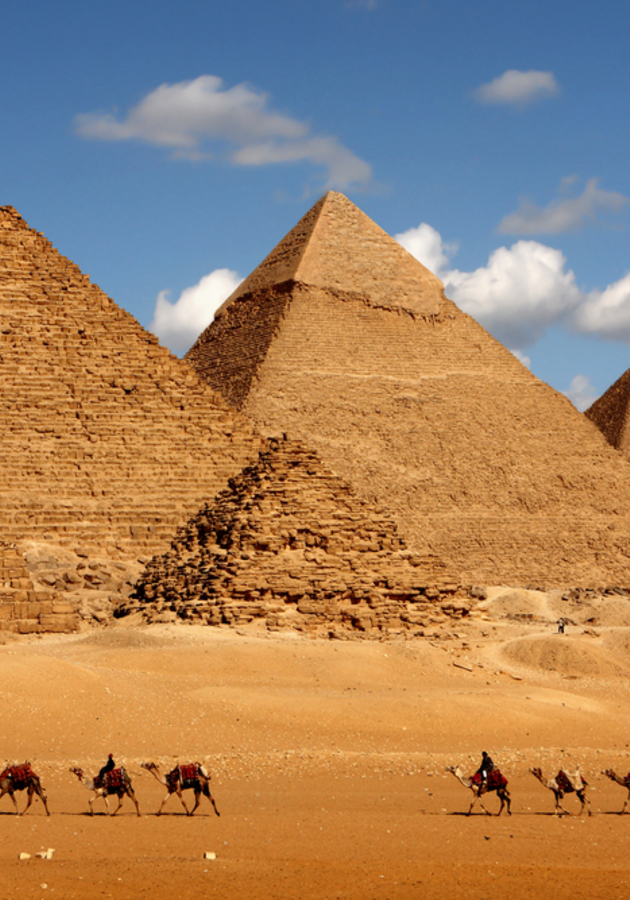“The construction of the Pyramid at Memphis is beyond the strength of men and its description is beyond belief, for it is a mountain placed on top of a mountain, and it is not easy for the mind to grasp how the huge masses of hewn stone could have been raised; and, indeed, all have doubts concerning the huge force of the mechanical devices needed to bring its massive structure together.” Such were the words Philo of Byzantium wrote in either the second century BC or the fourth century CE, acknowledging that the Great Pyramid of Giza, the oldest of all Seven Wonders of the Ancient World, was scarcely buildable in his time and age. The fact that this is also the only Wonder which substantially survives to this day is rather telling of the remarkable achievements of ancient Egypt.
To Philo, the Great Pyramid was even more ancient than he is to us. Built sometime between 2700 and 2500 BC, during the reign of a pharaoh the Ancient Egyptians knew as Khnum Khufu, it was the tallest structure made by human hands for about four millennia, until it was finally surpassed by the Lincoln Cathedral spire in 1311. To this day, we know neither how the Pyramid was built exactly, nor how its architects achieved such remarkable accuracy of construction. Hence, we can marvel at it with the awe Philo felt two millennia ago, surprised anew at how much can be achieved by apparently the simplest of means. We can also speculate much more knowledgeably than Philo, and that’s precisely what we’re about to get into!
The Golden Ages of Egypt
The ancient Greeks may have considered themselves the pinnacle of civilization, but even they were a little in awe of Egypt’s obvious antiquity. How couldn’t they have been? The historical records of ancient Egypt go back to the 32nd century BC, when, according to a long-standing Egyptian tradition, a capable ruler by the name of Menes unified Upper and Lower Egypt into a single kingdom and proclaimed himself the first pharaoh of the First Egyptian Dynasty. Until the country fell under Macedonian rule in 332 BC, Egypt’s social structure, its culture and customs, as well as its art and architecture, remained remarkably constant for a full three millennia. Since the history of ancient Egypt occurred as a series of stable kingdoms separated by periods of relative instability, historians tend to split the 3,000 years into three Golden Ages (Old, Middle and New Kingdoms), interspersed between as many Intermediate Periods, often considered times of crises or Dark Ages.
Egypt reached the pinnacle of its power in the New Kingdom, which began around 1570 BC with pharaoh Ahmose I, the founder of the 18th Dynasty of Egypt, and lasted all the way to 1077 BC and the reign of Ramesses XI, the tenth and final pharaoh of the 20th Dynasty of Egypt. By reorganizing the administration of the country and kickstarting massive construction projects, Ahmose I managed to centralize the government after 200 years of disarray and put an end to the political division which marked the Second Intermediate Period. Four centuries before him, Mentuhotep II, the sixth ruler of the 11th dynasty, managed a similar feat when he reunited Egypt after the First Intermediate Period and became the first pharaoh of the Middle Kingdom. The Middle Kingdom lasted from approximately 2040 BC to 1802 BC, when ancient chroniclers date the death of Sobekneferu, the first known female pharaoh and the last ruler of the 12th dynasty of Egypt.
It is the Old Kingdom of Egypt, spanning from about 2700 BC to 2200 BC, that interests us the most for our present purposes. Most commonly regarded as the period from the Third to the Sixth Dynasty, the Old Kingdom is also known as the “Age of the Pyramids,” as it encompasses the reigns of the great pyramid-builders of the Fourth Dynasty, such as King Sneferu – who perfected the art of pyramid-building – and the kings Khufu, Khafre and Menkaure, who constructed the pyramids at Giza. However, the monumental use of stone in tomb building began a bit earlier with Djoser, the first king of the Third Dynasty and the very founder of the Old Kingdom. Ancient sources tell us that Djoser moved the royal capital of Egypt to Memphis, about 12 miles (20 km) south of Giza, and ordered his ingenious architect Imhotep to build him a pyramid for a tomb. The Pyramid of Djoser, also known as the Step Pyramid, survives to this day. It is the oldest one in the world.
Pyramids and Ancient Egypt
There are more than 80 pyramids in Egypt, built over a period of around 1,000 years. Raised as superstructures of royal tombs, all of them were designed to protect the pharaoh after his death and assist him in his ascension to heaven. Because of this, the shape is often interpreted as a symbolic ramp up to the sky; the higher the ramp, the easier for the king to get into heaven. It is also associated with Benben, the primeval mound which emerged from the waters of chaos at the beginning of time, according to Egyptian creation myths, and which was said to have turned into a small pyramid. The Benben stone, named after this mound, was a sacred stone kept at the temple of Ra at Heliopolis; it was believed to be the location on which the first rays of the sun fell. Hence, the pyramidal shape may have been thought of as a solar symbol as well, representing in solid form the oblique rays of sunlight which are sometimes seen breaking through the clouds.
Originally standing 205 feet (63 m) tall, the Step Pyramid of Djoser is considered the earliest colossal stone building in Egypt and the very first large-scale cut stone construction made by human hands. Even so, it was not a true pyramid, prompting Sneferu, the founding pharaoh of the Fourth Dynasty of Egypt, to seek ways to improve on Imhotep’s plans and create an even more impressive tomb for himself. His first attempt, the Pseudo-Pyramid at Meidum, collapsed in a downpour while the building was still under construction because Sneferu’s approach was affected by two severe construction errors. Namely, not only were the platforms of the inner steps not horizontal, but also the outer layer was founded on sand, rather than on rock as was the case with the inner layers. Sneferu’s architects learned from their mistakes and went on to work on another pyramid. Due to their miscalculations, this second pyramid had the angle of its inclination altered from 54 to 43 degrees part-way through construction, and this earned the completed edifice the unflattering moniker of “the Bent Pyramid.”
Undaunted, Sneferu’s architects had a third and final go, and this time, they commenced construction at the inclination of 43 degrees. It is not difficult to surmise today that they must have realized, while working on the Bent Pyramid, that the inclination they used for the top section was less susceptible to instability and catastrophic collapse. Around 2550 BC, they finally completed this third pyramid, the first true pyramid in history. Known today as the Red Pyramid for the rusty hue of its red limestone stones, it features a noticeably squat appearance compared to other Egyptian pyramids of similar scale, due to its shallow angle of inclination. It is, nevertheless, the third largest pyramid ever built after those of Sneferu’s son Khufu and his grandson Khafre at Giza, neither of which would have been possible in the absence of Sneferu's determination and the engineering innovations of his now-forgotten architects. Even though the Pyramid of Khafre is almost as large as the Great Pyramid of Khufu, it somehow fails to arouse the same interest. Indeed, it was Khufu’s pyramid that made it to the original list of the Wonders of the World.
Size and construction
Composed of more than two million blocks of stone, the Great Pyramid of Khufu features a base of 756 square feet (230 sq m) and a volume of roughly 92 million cubic feet (2.6 million cubic meters). Originally, it rose to the impressive height of 481 feet (146 m), but what survives of it today is only the underlying core structure, which is slightly shorter. The majority of the smooth white limestone casing of the Pyramid was regrettably removed in the Middle Ages, and this lowered the pyramid’s height to the present 455 feet (139 m). Thankfully, a small portion of the casing survives at the top of Khafre’s Pyramid, providing an enticing glimpse of the pyramids’ original appearance. The failed Bent Pyramid of Sneferu is the only one of the 80 or so pyramids so far excavated in Egypt whose outer limestone casing remains largely intact. Modern researchers believe this is due to the larger clearances between the different parts of the casing of the Bent Pyramid, which worked as inadvertent expansion joints and prevented its destruction by thermal expansion.
The casing blocks of the Great Pyramid, each of which must have weighed about 2.5 tons, were closely set; in fact, it is often impossible to slide a knife-blade between the surviving ones. To fill the remaining gaps between them, the builders regularly used gypsum mortar, which also gave the outer casing an illusion of seamlessness from afar. Even though they used nothing more than the simplest of tools, these ancient builders were able to achieve an astonishing degree of accuracy in the construction of the Great Pyramid. For example, the level of the pavement around it varies by only about half an inch (1.5 cm) and its sides, set at an angle slightly less than 55 degrees, deviate from true north by an average of around 3 minutes of a degree. Several methods have been proposed for how this level of accuracy was achieved. Most frequently, however, it is supposed that water-filled trenches facilitated the levelling of the site, and that plumb lines and observations of the circling stars at night permitted the nearly perfect alignment of the sides with the cardinal points.
Even though, with regard to the construction techniques, such consensus has never been reached, we can be fairly sure that sand-assisted copper saws and long levers were used, as were hard stones, water-swollen wedges, log rollers and sand ramps. Contrary to popular belief, the builders of the pyramids weren’t slaves, but conscripted laborers. At least some of them were permanent, but the majority were seasonal employees, working for a fixed salary during the summer months (when the annual Nile flood prevented work in the fields) or as a form of tax payment to the pharaoh (levy). In 1990, not that far from the Pyramid, a tourist accidentally unearthed a modest mud-brick tomb holding a dozen skeletons. Subsequent archaeological research revealed that the tomb was more than 4,000 years old and that it belonged to people who worked on the Great Pyramid. Since then, even some of the houses of the builders have been dug up. They resemble the pyramids in miniature, complete with little false doors.
The tainted legacy of Khufu
The common misconception that the pyramids were built by slaves can be traced back to the Old Testament and the ancient Greeks. Herodotus, the first major author to discuss the Great Pyramid, erroneously claims that gangs of 100,000 men worked on the building in three-month shifts, completing the edifice in about two decades. Modern researchers believe that the pyramid was actually built in 30 years, but only by one-tenth of the workforce Herodotus wrote about after visiting Egypt around 450 BC. For Herodotus, Khufu – whom he names Cheops in Ancient Greek – was a tyrannical ruler who cruelly exploited his own people, including the members of his family. “Cheops was such an evil man,” he writes, “that, needing money, he put his own daughter in a brothel and made her charge a fee. She did as her father told her, but wanting to leave a memorial of her own, asked of each coming to her that he give one stone; and of these stones, they said, the Great Pyramid was built.”
Writing four centuries after Herodotus, Diodorus Siculus further strengthened the connection between pyramid building and slavery, claiming that Khufu was never buried in his own pyramid, but rather in a secret place, for fear that the people forced to build his tomb would seek out his body for revenge. In truth, one of the very few things we know about Khufu and his reign is that he was buried inside the Great Pyramid, in a sarcophagus placed in the so-called King’s Chamber located at one third the vertical height of the Great Pyramid. Above it, there are five “relieving rooms,” intended to reduce the weight of masonry pressing down on the King’s Chamber. One of the blocks of the relieving rooms holds ancient graffiti, written in hieroglyphs of red paint, which has survived to this day. It says: “The white crown of Khnum-Khufu is powerful.” Moreover, Khufu’s names are spelled out on the walls of the relieving chambers over a dozen times; it’s likely all of this graffiti was the work of the pyramid-builders.
During the first half of the 20th century, several cemeteries were excavated in the vicinity of the Great Pyramid, most of them belonging to family members and high officials of Khufu. This would have been in full accordance with ancient Egyptian rituals, which required relatives and courtiers to be buried next to the king they had served during life. Even more convincingly, in 1954, in an airtight pit beneath 41 large blocks of limestone, Khufu’s “solar boat” was discovered on the south side of the pyramid. Made from 1,274 pieces of wood fit together without a single metal nail, the boat is a masterpiece of woodcraft, and is believed it could still sail today if put on a lake or a river. It was probably never meant to, though, as it was actually a ritual vessel, built to carry Khufu into the afterlife. Since Khufu’s solar boat does bear some signs of having been used in water, there are some historians who think that it might have been also used as a funerary “barge” which carried Khufu from Memphis to his final resting place in Giza.
Interior and later life
The Great Pyramid is unique in the complexity of its internal arrangements. In addition to the King’s Chamber, it includes two more secret rooms, one of which – the Queen’s Chamber – is also built within the body of the pyramid, whereas the lowest one is cut into the bedrock upon which the pyramid stands. The King’s Chamber is entirely lined with red granite and contains a sarcophagus from the same material. Narrow shafts, approximately 8 square inches (20 sq cm), lead from the two upper chambers and are aligned toward the constellation Orion and the polar stars to allow the dead king’s soul to travel in their direction. Possibly because Khufu was buried with immense treasures, his architects went to great lengths to try and secure his sarcophagus. Among other things, they invented elaborate portcullis and plugging mechanisms to seal the entrance corridors. Even so, not long after the Great Pyramid was built, robbers were able to enter and loot Khufu’s tomb, probably by hacking another tunnel around the corridors, or using the escape route of the burial crew.
By the time the Arab conquest of Egypt occurred in the 7th century AD, sight of any entrance to the pyramid was probably lost altogether. Even so, the prospect of secret chambers full of ancient riches and mysterious knowledge enticed many robbers and adventurers to try and make their way inside the pyramid. The most famous of these attempts occurred in 832, when al-Mamun, son of Harun al-Rashid of “The Arabian Nights,” ordered the breaching of the Great Pyramid, searching for treasure or lost knowledge. Al-Mamun’s team forced their way into the fabric of the monument and eventually encountered the top of a descending corridor where it intersected with another corridor rising at an angle into the body of the pyramid. After they gained full access into the ascending corridor, the Arabs easily reached the Grand Gallery and Khufu’s burial chamber. However, they found nothing inside but his empty sarcophagus. Legend has it that al-Mamun had to smuggle a fake treasure into the chamber to avoid the dangerous disappointment of his people.
The passage dug by al-Mamun’s men – commonly known as the Robbers’ Tunnel – is the path along which tourists enter the Great Pyramid of Khufu today. Despite extensive damage, this marvelous building still stands, relatively intact considering its age, looking as if it will last forever. And, who knows, maybe it also hides at least one more mystery! In 2017, physicists used muon detectors to discover a large and enigmatic 30-meter-long void just above the King’s Chamber. Even though most modern researchers believe it to be another relieving room, as of 2021, the chamber isn’t excavated yet, so we don’t know what it holds or what its original function was. What we do know is that very few buildings – if any – raised in our day and age are likely to remain standing in the year of 6560, and probably none of them would be as interesting to future generations as the Great Pyramid is to us. To quote Philo of Byzantium once again, “It is certainly only by works of this kind that men can rise to the level of gods, or what’s more, that the gods may come down to man.”
Sources
Main
- Paul Jordan, Seven Wonders of the Ancient World (Routledge, 2002).
- Christopher Scarre, ed. The Seventy Wonders of the Ancient World (Thames & Hudson, 1999).
Ancient
- Diodorus Siculus, Library of History i.63-64. [https://penelope.uchicago.edu/Thayer/E/Roman/Texts/Diodorus_Siculus/1C*.html#63]
- Herodotus, The Histories ii.124-126. [https://www.perseus.tufts.edu/hopper/text?doc=Perseus%3Atext%3A1999.01.0126%3Abook%3D2%3Achapter%3D124]
- Philo of Byzantium, “On the Seven Wonders of the World” [Translation by Jean Blackwood] (August 23, 2019). [https://www.roger-pearse.com/weblog/2019/08/23/philo-of-byzantium-on-the-seven-wonders-of-the-world-an-english-translation-and-some-notes/]
Other
- Peter D’Epiro & Mary Desmond Pinkowish, What Are the Seven Wonders of the World?: And 100 Other Great Cultural Lists (Anchor, 1998), pp. 179-187.
- Joshua J. Mark, “Great Pyramid of Giza,” World History Encyclopedia (December 19, 2016). [https://www.worldhistory.org/Great_Pyramid_of_Giza/]
- “Great Pyramid tombs unearth ‘proof’ workers were not slaves,” The Guardian (January 11, 2010). [https://www.theguardian.com/world/2010/jan/11/great-pyramid-tombs-slaves-egypt]
- Jo Marchant, “Cosmic-ray particles reveal secret chamber in Egypt's Great Pyramid,” Nature (November 2, 2017). [https://www.nature.com/articles/nature.2017.22939]




























